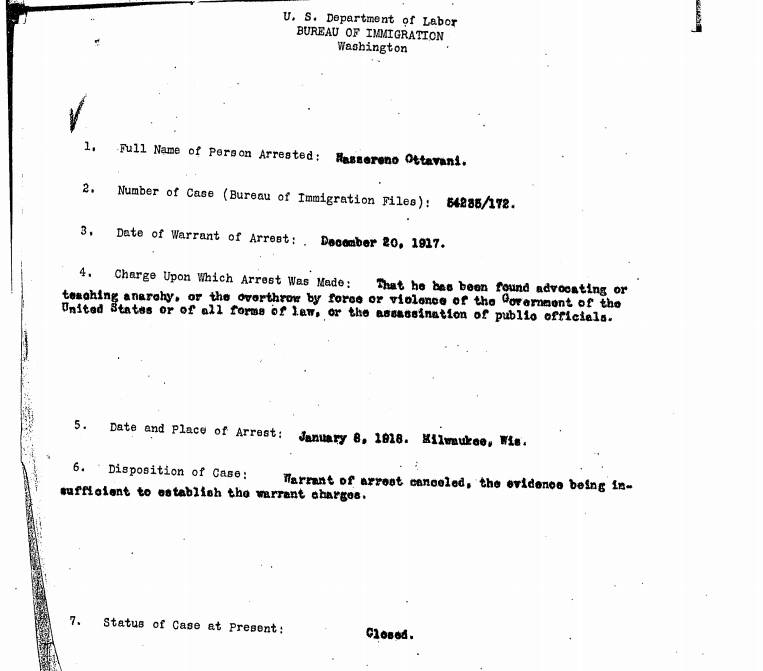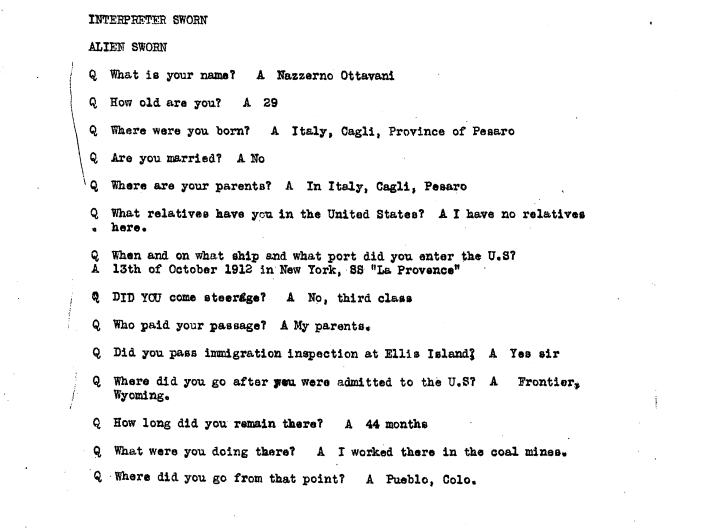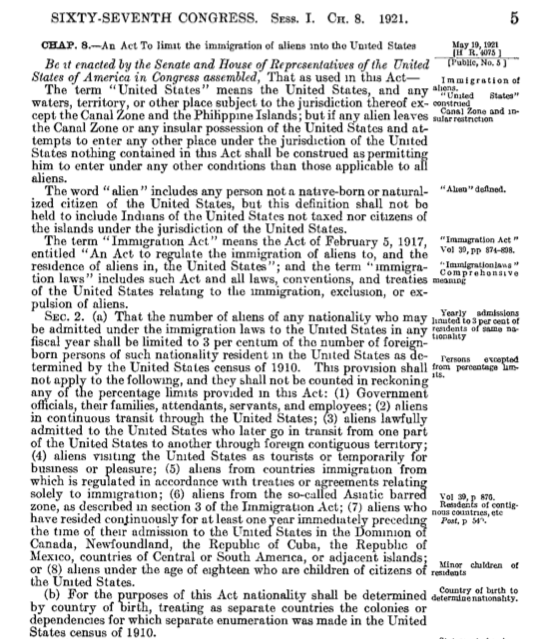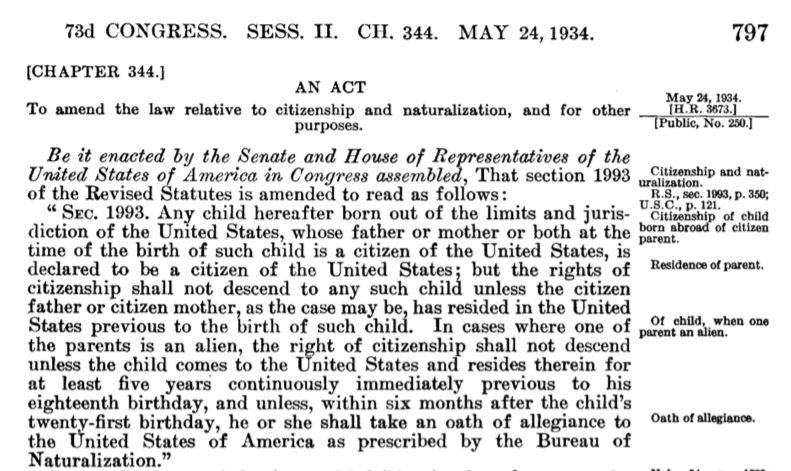

This document is the excerpt of a report of 14 pages from the Immigration Service send by the Office of District Director Chicago, Illinois. It contains information about aliens from 1917 to 1927 which is a large period. This source was created to leave a trace of those cases and use them if needed. This item is interesting because it shows various aspects of immigration during this period. The case is about a warrant of arrest which has been canceled. The alien is an Italian immigrant who had been arrested because of mistaken accusations on the fact that he is an anarchist and so violated the Immigration Act of 1917 which restricted the immigration of a particular category of people. The interview is full of information, the questions asked are very diverse, it goes from his name to his political belief by the way of the condition of his arrival in the US. This excerpt of the report is very interesting because it allows us to penetrate the history and to know how the immigrants were treated but also processed by the system. It also indicates the tension during the years 1917-1918, which are the last years of the First World War that occurred in Europe. This item rings the bells about the famous Sacco and Vanzetti case that became a movie. This film depicts the trial of Sacco and Vanzetti, two Italians accused and killed because of mistaken accusations but also mistrust regarding immigrants. The film revisits their history and how US population experienced the trial and faced the injustice.

This source is an excerpt of the Emergency Quota Act. The purpose of this act was to restrict the number of immigrants that arrived in the US regarding countries. World War I had devastated many countries in Europe and the good economy of the US attracted a lot of people who looked for a better life. In the early 19th century, millions of immigrants arrived in the US and the government started to react and create new policies to calm this huge arrival of aliens. Immigrants coming from specific countries such as Northern European ones were more welcomed and more numerous than immigrants from Eastern and Southern Europe. Furthermore, this act was revised by the Immigration Act of 1924. In spite of this act, the European immigration was very intense before and after the WWI and the effect of this massive immigration still remains today in American society as a whole.
Comprehensive Immigration Law (1924)
[…] Now, therefore I, Calvin Coolidge, President of the United States of America acting under and by virtue of the power in me vested by the aforesaid act of Congress, do hereby proclaim and make known that on and after July 1, 1924, and throughout the fiscal year 1924-1925, the quota of each nationality provided in said act shall be as follows:
COUNTRY OR AREA OF BIRTH QUOTA 1924-1925
Afghanistan- 100
Austria- 785
Belgium (5)- 512
Bulgaria- 100
Cameroon (French mandate)- 100
China- 100
Czechoslovakia- 3,073
Denmark (5, 6)- 2,789
Egypt- 100
Finland- 170
France (1, 5, 6)- 3,954
Germany- 51,227
Great Britain and Northern Ireland (1, 3, 5, 6)- 34,007
Greece- 100
Hungary- 473
India (3)- 100
Iraq (Mesopotamia)- 100
Irish Free State (3)- 28,567
Italy, including Rhodes, Dodecanesia, and Castellorizzo (5)- 3,845
Japan- 100
Lithuania- 344
Muscat (Oman)- 100
Nepal- 100
Poland- 5,982
Rumania- 603
Sweden- 9,561
This source is the Immigration Act of 1924, also called the Johnson-Reed Act written by the US government to limit the immigration in the US. It depicts the characteristics of this law but also informs about the quotas. The US wanted to limit the number of immigrants who entered the country, they used a quota based on origins. They made distinctions between Europeans and Asians for example, this distinction can be perceived as racist. There is another aspect of US policies during the immigration period. This item permits a better understanding of the US policies at this period, it informs people about the law and what it produced but also helps understand why this law was signed. As the excerpt shows, the US favored the entry of white skin immigrants. The act limited the number of immigrants allowed entry into the United States through a national origins quota. This quota provided immigration visas to a certain number of people of each nationality in the United States. It completely excluded immigrants from Asia. This item teaches us about inequalities and so tensions that some American laws created. This document is very representative of US laws against the massive immigration.

This document is an act that was voted after the creation of the bill to amend the law relative to citizenship and naturalization and to other purposes, 72d Congress. December 11, 1931. It deals with immigration but more specifically with the results and the reactions of US Congress. This document was created during the 73d Congress, the bill became an official act and the Congress make it public. This document shines a light on the reaction of the US government to immigration. In addition to this, this item offers a better comprehension of how the immigrants managed to become US citizens. This item allows showing all the aspects of immigration and the period that it belongs to. Being aware of how immigrants came and how many they were is important but the overall process is even more interesting and the bills about immigration still have an impact on the country nowadays. This source clarifies terms and answers a lot of the questions that I have about how an immigrant and a family become citizens of the US, about how long is the process and about the law regarding the children. The reading of this document provides more knowledge about the immigration policies in the 1930s.
